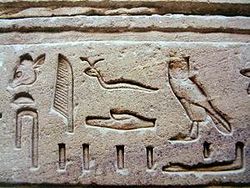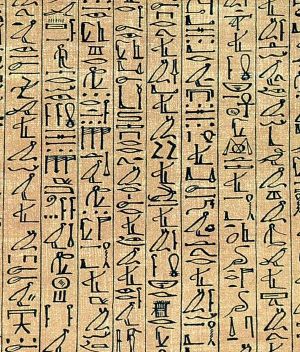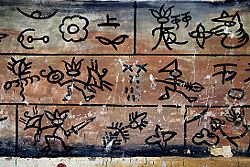Hieroglyph
A hieroglyph is a character of a logographic or partly logographic writing system. The term originally referred to the Egyptian hieroglyphs, but is also applied to the ancient Cretan Luwian, Mayan and Mi'kmaq scripts, and occasionally also to Chinese characters. It was also used by Ancient Egyptians. Ancient Egyptian writing consisted of over 2,000 hieroglyphic characters where as the English only consists of 26. Each hieroglyphic characters represent a common object from their day.
Etymology
The word Hieroglyphs derives from the Greek words ἱερός (hierós 'sacred') and γλύφειν (glúphein 'to carve' or 'to write', see glyph), and was first used to describe Egyptian hieroglyphs. The Greeks who came to Egypt prior to and during the Ptolemaic Period (305 B.C.E. - 30 B.C.E.) observed that while demotic script was employed for secular documents, pictorial characters were frequently found in religious contexts - carved on temple walls and funerary structures, as well as on official monuments.
The word "hieroglyphics" is derived from the fact that the Greeks called Egyptian hieroglyphs τά ἱερογλυφικά γράμματα 'hieroglyphic letters'; however, they sometimes simply dropped the word γράμματα, "letters," calling them τά ἱερογλυφικά 'the hieroglyphics' ('letters' being understood). This was used in informal use.
In the same way, although the term "hieroglyphics" is still used today, this usage adds a tone of informality (such as in the above example of Greek practice). An alternative is to use the noun "hieroglyphs" for both the language as a whole and for the individual characters that compose it, or to use the term "hieroglyphic" as an adjective (e.g., a hieroglyphic writing system).
Types
Egyptian hieroglyphs
Egyptian hieroglyphs (pronounced /ˈhaɪərəʊɡlɪf/; from Greek ἱερογλύφος "sacred carving", also hieroglyphic = τὰ ἱερογλυφικά [γράμματα]) was a formal writing system used by the ancient Egyptians that contained a combination of logographic and alphabetic elements. Egyptians used cursive hieroglyphs for religious literature on papyrus and wood. Less formal variations of the script, called hieratic and demotic, are technically not hieroglyphs. Hieroglyphs consist of three kinds of glyphs: phonetic glyphs, including single-consonant characters that functioned like an alphabet; logographs, representing morphemes; and determinatives, which narrowed down the meaning of a logographic or phonetic words.
Hieroglyphs emerged from the preliterate artistic traditions of Egypt. For example, symbols on Gerzean pottery from circa 4000 B.C.E. resemble hieroglyphic writing. For many years the earliest known hieroglyphic inscription was the Narmer Palette, found during excavations at Hierakonpolis (modern Kawm al-Ahmar) in the 1890s, which has been dated to circa 3200 B.C.E. However, in 1998 a German archaeological team under Günter Dreyer excavating at Abydos (modern Umm el-Qa'ab) uncovered tomb U-j of a Predynastic ruler, and recovered three hundred clay labels inscribed with proto-hieroglyphs, dating to the Naqada IIIA period of the 33rd century B.C.E.[1][2] The first full sentence written in hieroglyphs so far discovered was found on a seal impression found in the tomb of Seth-Peribsen at Umm el-Qa'ab, which dates from the Second Dynasty. In the era of the Old Kingdom, the Middle Kingdom and the New Kingdom, about 800 hieroglyphs existed. By the Greco-Roman period, they numbered more than 5,000.[3]
Cursive hieroglyphs
Cursive hieroglyphs are a variety of Egyptian hieroglyphs commonly used for religious documents written on papyrus, such as the Book of the Dead. It was particularly common during the Ramesside Period and many famous documents, such as the Papyrus of Ani, utilize it. It was also employed on wood for religious literature such as the Coffin Texts.
Cursive hieroglyphs should not be confused with hieratic. Hieratic is much more cursive, having large numbers of ligatures and signs unique to hieratic. However, there is, as might be expected, a certain degree of influence from hieratic in the visual appearance of some signs. One significant difference is that the orientation of cursive hieroglyphs is variable, reading right to left or left to right depending on the context, whereas hieratic is always read right to left.[4]
Dongba script
The Dongba, Tomba or Tompa script is a pictographic writing system used by the ²dto¹mba (Bon priests) of the Naxi people. In the Naxi language it is called ²ss ³dgyu 'wood records' or ²lv ³dgyu 'stone records'[5]. Together with the syllabic geba and the Latin alphabet, it is one of the three types of Naxi scripts. Dongba script is about a thousand years old. Although the glyphs look like crude pictographs that only represent simple materialistic objects, they are actually ideograms capable of representing abstract ideas. [6] Dongba writings are sometimes used as a rebus. It is a mnemonic system, and cannot by itself represent the Naxi language; different authors may use the same glyphs with different meanings, and it is often supplemented with the syllabic geba script for clarification.
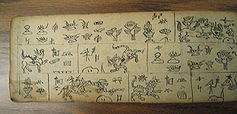 |
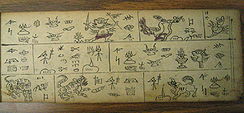
|
The Dongba script is an independently developed ancient writing system. According to Dongba religious fables, the Dongba script was created by the founder of the Bön religious tradition of Tibet, Tönpa Shenrab (Tibetan: ston pa gshen rab) or Shenrab Miwo (Tibetan: gshen rab mi bo)[7]. Unfortunately, there is currently no accurate record of the exact date of the Dongba script origin and many suspected that the fables provided only fictional explanation to the foundation of this script. From Chinese historical documents, however, it is certain that Naxi script was used as early as the 7th century during the early Tang Dynasty. By the Song Dynastry in 10th century, Dongba script was widely used by the Naxi people.[8]
Cretan hieroglyphs
Anatolian hieroglyphs
=Hieroglyphic Luwian
Mayan hieroglyphs
Olmec hieroglyphs
Mi'kmaq hieroglyphic writing
Chinese characters
Notes
- ↑ The origins of writing, Discovery Channel (1998-12-15)
- ↑ Richard Mattessich (Jun 2002) The oldest writings, and inventory tags of Egypt, The Accounting Historians Journal.
- ↑ Antonio Loprieno, Ancient Egyptian; A Linguistic Introduction, Cambridge University Press, 1995 p.12
- ↑ Davies 1990:93
- ↑ He, 292
- ↑ He, 2008, p.146
- ↑ He, 144
- ↑ He, 144
ReferencesISBN links support NWE through referral fees
- Robinson, Andrew. The story of writing with over 350 illustrations, 50 in color. New York: Thames & Hudson 2003. ISBN 0500281564
- Andrew Robinson (2007). Alphabets, Hieroglyphs and Pictograms, London: Thames & Hudson.
- Angelika Rauch (1997). The Hieroglyph of Tradition, Fairleigh Dickinson Univ Press.
- Douglas J (2007). Egypt and the Egyptians, UK: Cambridge University Press.
- Cruz-Uribe, Eugene. 2001. "Scripts: An Overview." In The Oxford Encyclopedia of Ancient Egypt, edited by Donald B. Redford. Vol. 3. Oxford, New York, and Cairo: Oxford University Press and The American University in Cairo Press. 192–198 [194–195].
- Davies, William Vivian. 1990. "Egyptian Hieroglyphs." In Reading the Past: Ancient Writing from Cuneiform to the Alphabet. London: British Museum Press. 74–135.
External links
Credits
New World Encyclopedia writers and editors rewrote and completed the Wikipedia article in accordance with New World Encyclopedia standards. This article abides by terms of the Creative Commons CC-by-sa 3.0 License (CC-by-sa), which may be used and disseminated with proper attribution. Credit is due under the terms of this license that can reference both the New World Encyclopedia contributors and the selfless volunteer contributors of the Wikimedia Foundation. To cite this article click here for a list of acceptable citing formats.The history of earlier contributions by wikipedians is accessible to researchers here:
The history of this article since it was imported to New World Encyclopedia:
Note: Some restrictions may apply to use of individual images which are separately licensed.
